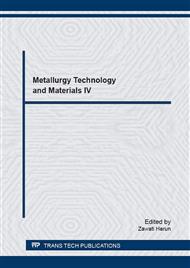[1]
S. Kathirvale, M.N.M. Yunus, K. Sopian, A.H. Samsuddin. Energy potential from municipal solid waste in Malaysia. Renewable Energy, 29(2003)559-567.
DOI: 10.1016/j.renene.2003.09.003
Google Scholar
[2]
P. Colin, R. Tim. Energy from waste: an evaluation of conversion technologies. Elsevier Applied Science, New York, (1985).
Google Scholar
[3]
C.D. Cooper, B. Kim, J. MacDonald. Estimating the lower heating values of hazardous and solid wastes. Journal of the Air & Waste Management Association, 49(1999)471-476.
DOI: 10.1080/10473289.1999.10463816
Google Scholar
[4]
M.B. Chang, C.K. Huang. Characteristics of energy flow in a municipal solid waste incinerator. Journal of Environmental Engineering ASCE, 127(2001)78-81.
DOI: 10.1061/(asce)0733-9372(2001)127:1(78)
Google Scholar
[5]
N.B. Chang, Y.H. Chang, W.C. Chen. Evaluation of heat value and its prediction for refuse-derived fuel. The Science of the Total Environment, 197(1997)139-148.
DOI: 10.1016/s0048-9697(97)05425-9
Google Scholar
[6]
X.L. Li, M.L. Hu. Effective approach to improving heat value of domestic waste: primary probe into heat value of municipal domestic waste in Xiamen city. Environmental Sanitation Engineering, 15(2007)46-48.
Google Scholar
[7]
P.F. Sun, X.D. Li, Y. Chi, J.H. Yan. The study on prediction of lower heat value of MSW. Energy Engineering, 5(2006)39-42.
Google Scholar
[8]
M. Khan, Z. Abu-Ghararah. New approach for estimating energy content of municipal solid waste. J. Environ. Eng., 117(1991)376-380.
DOI: 10.1061/(asce)0733-9372(1991)117:3(376)
Google Scholar
[9]
M. Abu-Qudaisa, H.A. Abu-Qdaisb. Energy content of municipal solid waste in Jordan and its potential utilization. Energy Conversion and Management, 41(2000)983-991.
DOI: 10.1016/s0196-8904(99)00155-7
Google Scholar
[10]
X.B. Lin, F. Wang, Y. Chi, Q.X. Huang, J.H. Yan. A simple method for predicting the lower heating value of municipal solid waste in China based on wet physical composition. Waste Management, 36(2015)24-32.
DOI: 10.1016/j.wasman.2014.11.020
Google Scholar
[11]
C.Q. Dong, B.S. Jin. Prediction of the heating value of municipal solid waste ( MSW) with the use of a neural network method. Journal of Engineering for Thermal Energy & Power, 17(2002)275-278.
Google Scholar


